A new extinct species of alligator lizard (Squamata: Elgaria) and an expanded perspective on the osteology and phylogeny of Gerrhonotinae
- PMID: 34587907
- PMCID: PMC8482661
- DOI: 10.1186/s12862-021-01912-8
A new extinct species of alligator lizard (Squamata: Elgaria) and an expanded perspective on the osteology and phylogeny of Gerrhonotinae
Abstract
Background: Alligator lizards (Gerrhonotinae) are a well-known group of extant North American lizard. Although many fossils were previously referred to Gerrhonotinae, most of those fossils are isolated and fragmentary cranial elements that could not be placed in a precise phylogenetic context, and only a handful of known fossils are articulated skulls. The fossil record has provided limited information on the biogeography and phylogeny of Gerrhonotinae.
Results: We redescribe a nearly complete articulated fossil skull from the Pliocene sediments of the Anza-Borrego Desert in southern California, and refer the specimen to the alligator lizard genus Elgaria. The fossil is a representative of a newly described species, Elgaria peludoverde. We created a morphological matrix to assess the phylogeny of alligator lizards and facilitate identifications of fossil gerrhonotines. The matrix contains a considerably expanded taxonomic sample relative to previous morphological studies of gerrhonotines, and we sampled two specimens for many species to partially account for intraspecific variation. Specimen-based phylogenetic analyses of our dataset using Bayesian inference and parsimony inferred that Elgaria peludoverde is part of crown Elgaria. The new species is potentially related to the extant species Elgaria kingii and Elgaria paucicarinata, but that relationship was not strongly supported, probably because of extensive variation among Elgaria. We explored several alternative biogeographic scenarios implied by the geographic and temporal occurrence of the new species and its potential phylogenetic placements.
Conclusions: Elgaria peludoverde is the first described extinct species of Elgaria and provides new information on the biogeographic history and diversification of Elgaria. Our research expands the understanding of phylogenetic relationships and biogeography of alligator lizards and strengthens the foundation of future investigations. The osteological data and phylogenetic matrix that we provided will be critical for future efforts to place fossil gerrhonotines. Despite limited intraspecific sampled sizes, we encountered substantial variation among gerrhonotines, demonstrating the value of exploring patterns of variation for morphological phylogenetics and for the phylogenetic placement of fossils. Future osteological investigations on the species we examined and on species we did not examine will continue to augment our knowledge of patterns of variation in alligator lizards and aid in phylogenetics and fossil placement.
Keywords: Anza-Borrego; Biogeography; Elgaria; Fossils; Gerrhonotinae; Morphology; Osteology; Phylogenetics; Pliocene.
© 2021. The Author(s).
Conflict of interest statement
The authors declare that they have no competing interests.
Figures







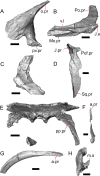



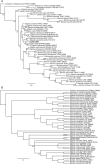
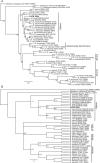
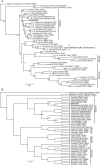




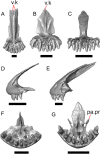




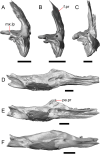







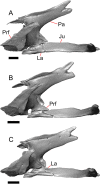







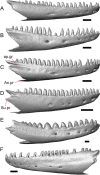







Similar articles
-
Variation in the skulls of Elgaria and Gerrhonotus (Anguidae, Gerrhonotinae) and implications for phylogenetics and fossil identification.PeerJ. 2021 Jul 22;9:e11602. doi: 10.7717/peerj.11602. eCollection 2021. PeerJ. 2021. PMID: 34327052 Free PMC article.
-
The skull of the gerrhonotine lizard Elgaria panamintina (Squamata: Anguidae).PLoS One. 2018 Jun 28;13(6):e0199584. doi: 10.1371/journal.pone.0199584. eCollection 2018. PLoS One. 2018. PMID: 29953469 Free PMC article.
-
Multilocus phylogeny of alligator lizards (Elgaria, Anguidae): Testing mtDNA introgression as the source of discordant molecular phylogenetic hypotheses.Mol Phylogenet Evol. 2017 May;110:104-121. doi: 10.1016/j.ympev.2017.02.010. Epub 2017 Feb 16. Mol Phylogenet Evol. 2017. PMID: 28212874
-
From fins to limbs to fins: limb evolution in fossil marine reptiles.Am J Med Genet. 2002 Oct 15;112(3):236-49. doi: 10.1002/ajmg.10773. Am J Med Genet. 2002. PMID: 12357467 Review.
-
A review of the non-semiaquatic adaptations of extinct crocodylomorphs throughout their fossil record.Anat Rec (Hoboken). 2025 Feb;308(2):266-314. doi: 10.1002/ar.25586. Epub 2024 Nov 25. Anat Rec (Hoboken). 2025. PMID: 39587416 Review.
Cited by
-
A Palaeogene stem crotaphytid (Aciprion formosum) and the phylogenetic affinities of early fossil pleurodontan iguanians.R Soc Open Sci. 2024 Jan 10;11(1):221139. doi: 10.1098/rsos.221139. eCollection 2024 Jan. R Soc Open Sci. 2024. PMID: 38204790 Free PMC article.
-
Body size estimation from isolated fossil bones reveals deep time evolutionary trends in North American lizards.PLoS One. 2024 Jan 5;19(1):e0296318. doi: 10.1371/journal.pone.0296318. eCollection 2024. PLoS One. 2024. PMID: 38180961 Free PMC article.
-
Identification of Late Pleistocene and Holocene fossil lizards from Hall's Cave (Kerr County, Texas) and a primer on morphological variation in North American lizard skulls.PLoS One. 2024 Aug 15;19(8):e0308714. doi: 10.1371/journal.pone.0308714. eCollection 2024. PLoS One. 2024. PMID: 39146299 Free PMC article.
-
The affinities of the Late Triassic Cryptovaranoides and the age of crown squamates.R Soc Open Sci. 2023 Oct 11;10(10):230968. doi: 10.1098/rsos.230968. eCollection 2023 Oct. R Soc Open Sci. 2023. PMID: 37830017 Free PMC article.
References
-
- Estes R. A new gerrhonotine lizard from the Pliocene of California. Copeia. 1963;1963:676–680. doi: 10.2307/1440971. - DOI
-
- Uetz P, Freed P, Hošek J (editors). The reptile database. http://www.reptile-database.org. 2020. Accessed 29 Apr 2021.
-
- Wilson RL. Systematics and faunal analysis of a lower Pliocene vertebrate assemblage from Trego County, Kansas. Contrib Mus Paleontol Univ Mich. 1968;22:75–126.
-
- Good DA. Phylogenetic relationships among gerrhonotine lizards: an analysis of external morphology. Univ Calif Publ Zool. 1988;121:1–139.
Publication types
MeSH terms
LinkOut - more resources
Full Text Sources
